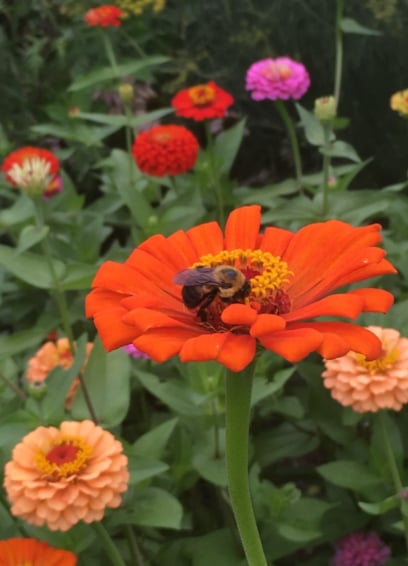By Kelsey Alexander
Sustainability Analyst
Sustainable Investment Group (SIG)
 LEED v4 Sustainable Sites Credit 1 and Credit 5 work to conserve existing natural site areas and restore damaged site areas to maintain or restore ecological integrity. To be able to earn this credit, sites must have native or adapted vegetation cover 20% of the area excluding the building footprint or 5% of the area including the building footprint. Why is it important to use native species, though?
LEED v4 Sustainable Sites Credit 1 and Credit 5 work to conserve existing natural site areas and restore damaged site areas to maintain or restore ecological integrity. To be able to earn this credit, sites must have native or adapted vegetation cover 20% of the area excluding the building footprint or 5% of the area including the building footprint. Why is it important to use native species, though?
Native plant species are plants that occur naturally in a region where they evolved, and they play a large role in biodiversity conservation. Biodiversity, which is the amount of variety in a specific ecosystem, is the main factor in ecosystem productivity, and plant diversity is a major component. If one component changes, then it causes a ripple effect. Native plants provide shelter and food, so they are the determining factor for what birds, insects, and animals can live within the community.1 This credit offers the option of limiting turf area to 25% or less of the total vegetated onsite area. Grass has become a vast monoculture carpet, with little to no environmental benefit, and it is estimated to cover over 40 million acres. Without these native plants, insects will disappear without their habitat, and then local birds would not be able to survive.2
There are substantial benefits to using native species in landscaping – both environmental and financial. Native plants assist with nutrient cycling, which is how nutrients move from the physical environment into living organisms and are then recycled back into the physical environment.3 They help combat the effects of climate change by storing CO2, and they regulate the food chain. When natural predators do not have their habitats destroyed, they are able to stop the prey population from growing and spreading.4 Exotic and nonnative plants are not able to host as many species as native plants, and they do not have any natural predators or competition in the region, so they are able to grow unchecked. This leads to invasive species like kudzu or Chinese privet that can overtake an area. Ecologically, native plants help regulate an ecosystem and are the best environmental choice.
Using native species also has a large financial benefit. In the United States, the market for natural products has been estimated at US $87 billion per year. These products include food, timber, paper, cosmetics, biotechnology, and more. Plants’ ability to take up CO2 also has financial benefits. One study estimated that a tropical rain forests’ ability to take in carbon dioxide is worth over US $46 billion per year.1 On top of that, native plants are much more low maintenance than a nonnative plant species. They require less artificial fertilizers and synthetic herbicides, and, because they have adapted to the local climate, native plants also require less water.2
What can we do? Even relatively small increases in native plant cover significant increases the number and species of breeding birds. It is also important to remember to either plant trees close to the windows or very far away. This reduces the trees’ reflection in windows and keeps birds from flying into the glass. It is important to research local birds and insects and use the plants that form their habitats. By using native species for landscaping, companies can benefit financially and maintain a healthy, viable ecosystem.
LEED Requirements
Demonstrate that there is no calcium chloride or sodium chloride deicers, or establish reduced treatment areas equal to 50% of applicable paving area. Prevent erosion and sedimentation and restore any eroded soils. Prevent air pollution from construction materials and activities. Divert from landfills 100% of plant material waste via low-impact means. Prevent the over application of nutrients and use no ammonia-based fertilizers, biosolid-based fertilizers, synthetic quick-release fertilizers, or “weed and feed” formulations. Blanket applications of herbicides are prohibited; turf weeds may be controlled by spot spraying only. Monitor irrigation systems manually or with automated systems at least every two weeks during the operating season and correct any leaks, breaks, inappropriate water usage, or incorrect timing. Store materials and equipment to prevent air and site contamination. And meet one of the following options:
SSc1:
Option 1. On-Site Restoration
Restore a minimum area of 5,000 square feet.
Option 2. Financial Support
If the project does not have enough habitat area to meet the requirements of Option 1, or does not wish to perform on-site restoration, they can give a minimum financial contribution of $0.05 per squared feet to a qualifying land trust or conservation organization every year.
SSc5:
Option 1. Limited turf area
Limit turf to 25% or less of the vegetated area. Playgrounds and athletic fields in schools or parks are excluded from this option.
OR
Option 2. All manual or electric-powered equipment
Use all manual or electric-powered equipment in all site management operations.
OR
Option 3. Reduction in emissions from site management equipment
Show and maintain a 50% reduction in hydrocarbon (HC) and nitrogen oxide (NOx) emissions, and a 75% reduction in carbon monoxide (CO) emissions from baseline conditions.
Source
1 http://www.bgci.org/plant-conservation/why_conserve
2 http://www.audubon.org/content/why-native-plants-matter
3 http://www.sswm.info/category/concept/nutrient-cycle
4 http://www.uky.edu/Classes/ENT/530/Lecture_Notes/feb11/feb11_files/frame.htm
© 2018 Sustainable Investment Group (SIG). All rights reserved.



